Eartips are an essential part of in-ear headphones. So much, in fact, that they can completely alter sound, depending also on how you wear them. Finding out the best eartips can be quite challenging, given the huge variety of different models and materials the market offer.
Single, double, triple flange; foam, silicone, a mix of the two; soft core or hard core; deep insert or shallow insert. All these options can be confusing. Back in the “earbud era”, there was one way of getting better isolation and comfort: using foams that enveloped the housings. With in-ear headphones things changed, and the new market for eartips has been rising in recent years.
Each ear is unique: not only do they change from one person to another, but also from left to right. As an example, my left ear canal is different from my right ear canal, so it is difficult for me to find eartips that fit both ears. Ear canals also change shape according to the jaw’s position and how the other head muscles flex.
It is important to try different sizes, so that you can find the one that best fits your ears. The right size will make the earphones sound as they are designed to, since you won’t lose bass (it happens when eartips are too small) or treble (may happen if eartips are too large).
This article is meant as a practical guide to the main eartips offerings on the market, for newbies and veterans alike. Although it does not feature each and every possible variation or brand, it will continue to evolve and include more and more options. Please feel free to suggest interesting alternatives!
How to wear eartips
Eartips should be inserted deep in the ear canal and provide a tight seal. The insertion should be complete, but not causing discomfort. Feeling uncomfortable is normal if you never used in-ear headphones before, and it takes a few hours to get accustomed to it. If you feel like you can’t stand wearing in-ear headphones for more than a few minutes, I suggest you to try removing them and then wait for a few hours before trying them out again. Your ears and your brain need to adapt to the new situation, so it may be better for you to start with little sessions.
You can tell you are not wearing the earphones correctly when you hear faint bass and/or pronounced treble – given these are not among the earphones’ features (i.e. HiFiMAN RE-00). If you try inserting them deeper, sound should become more coherent and musical; if that does not happen, suspect either eartips size (you may need larger tips) or earphones. You can compare what you hear with reviews online for additional confirmation.
The only real guide, however, is how comfortable you feel wearing the earphones. There is no real “right” or “wrong”; as long as you hear correctly, you can wear in-ear headphones the way you like.
Single flange silicone eartips
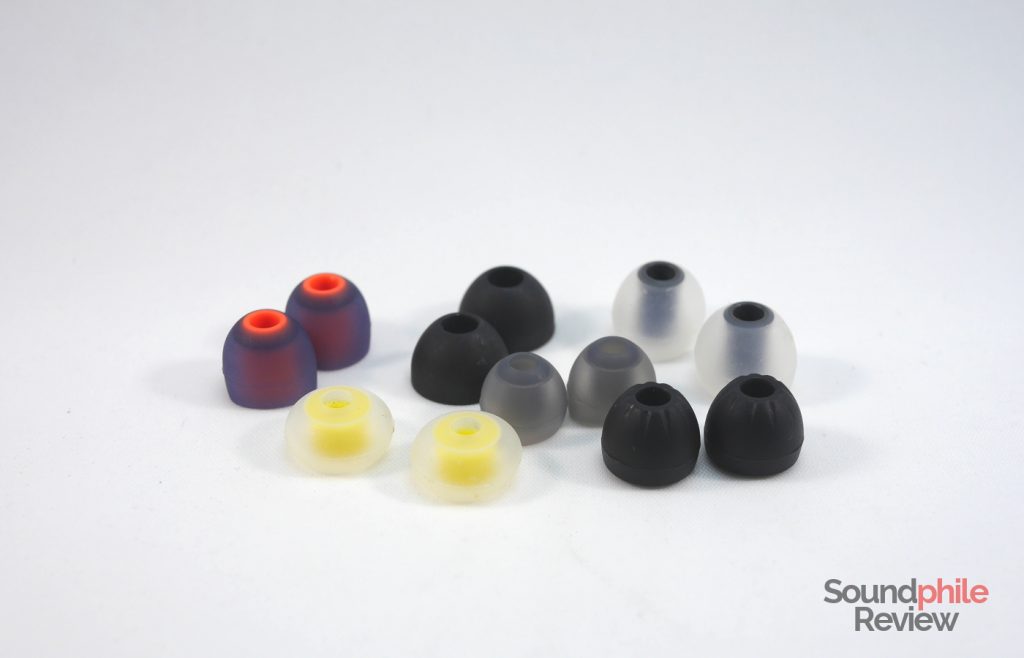
Single flange silicone eartips are the most commonly used eartips. Earphones provided with phones, as an example, are often equipped with this type of eartips. They are the simplest available, and the ones that can fit most ears; maintenance is also extremely simple, as they can be washed without special precautions.
Although they can have soft and hard cores, their sonic and comfort properties do not vary too much. As a matter of fact, they can be made from silicone of varying degrees of softness, and it only depends on your taste to decide which one you prefer. There may be differences in sound, but in my experience they are minor at most.
Comfort is average and isolation is good, though it heavily depends on the size. The double flange tips are better in this regard.
Double flange silicone eartips
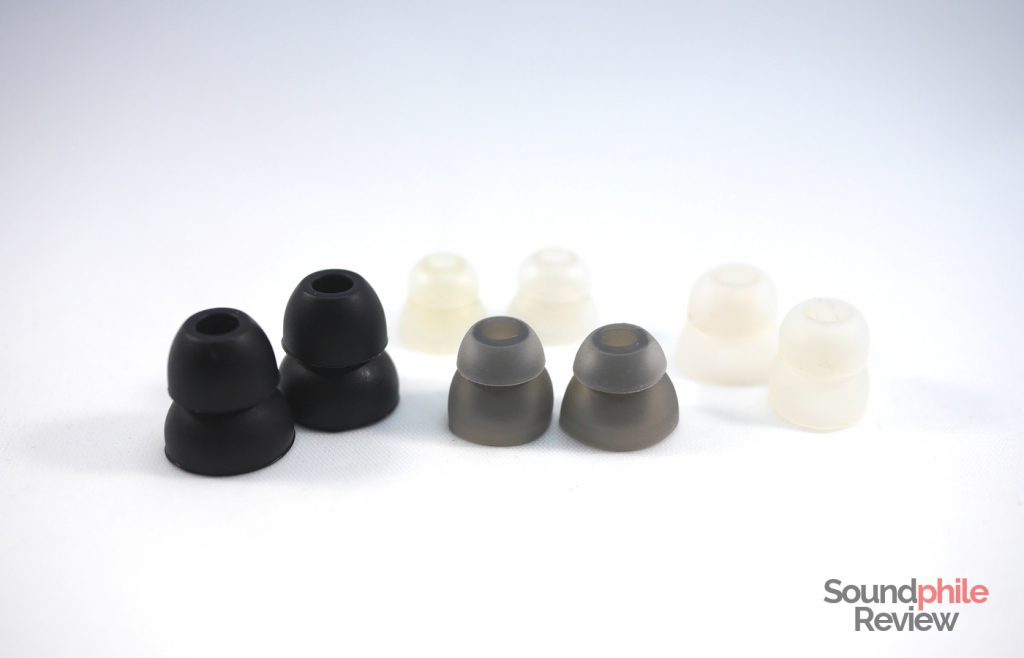
If you stacked two single-flanged eartips and glued them together, you would get double flange silicone eartips. They are usually the same size of the single-flanged ones, but there are two curves instead of one. The main advantage this feature affords to these tips is the fact that they can usually better adapt to one’s ear canal.
As the ear canal is not straight, the tip needs to follow its shape and two pieces can bend better than one. This means that comfort is better and isolation is also vastly improved. This is the main reason for the inclusion of this type of eartips in most audiophile or musician earphone boxes.
Most eartips of this kind are made of soft silicone, which also has a role in leading to great comfort. There are tips, such as the Spinfit, which use double-density silicone with a hard inner core and soft flanges.
Triple flange silicone eartips
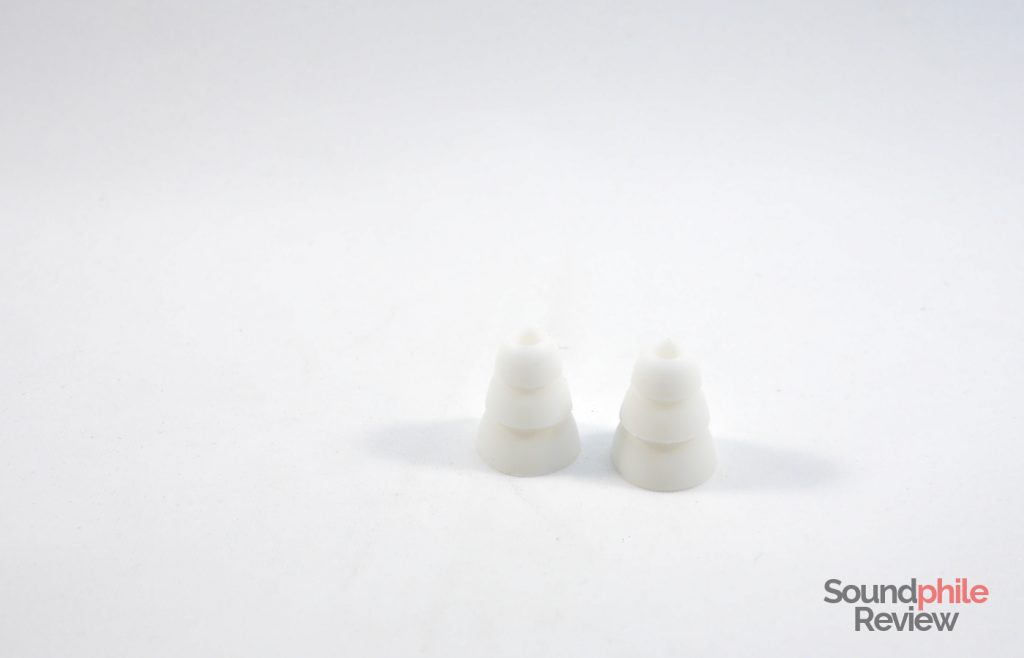
Adding one more level to the double-flanged eartips leads to the triple flange silicone eartips. These are the largest currently available (that I know of, at least) and also the last step for silicone eartips. They should provide added comfort and isolation and this is why you often see them being included with earphones made for musicians.
I wrote “should” because everyone’s experience is different and this claims may not hold true for each and every one of us. I find them especially uncomfortable becuase they tend to sit too deep in my ear canal, thus causing discomfort and pain in a matter of minutes. While this is just my experience and has no general validity, you may be like me and this is something I suggest you to consider.
The best rule is to try different options to see which one fits you best. If experienced companies like Shure include them in their earphone boxes, I trust they work well for a lot of people.
Foam eartips
An alternative to silicone eartips which has been on the rise among audiophiles is foam. Eartips made of foam often offer increased comfort and isolation when compared to silicone alternatives, though there are also disadvantages like the maintenance and higher price.
One of the first companies to introduce foam as a material for eartips is Comply, which spun out of 3M due to Mr. Bob’s interest in researching applications of foam in the audio industry – be it for headphones or professional devices such as ear plugs. His research on the matter concluded that the jaw’s position changes the shape of the ear canal. As the ear canal changes, so the earplugs (or tips) have to adapt to it. The optimal material was found to be foam, thanks to the fact it is soft, it can easily change its shape and it is relatively cheap to manufacture.
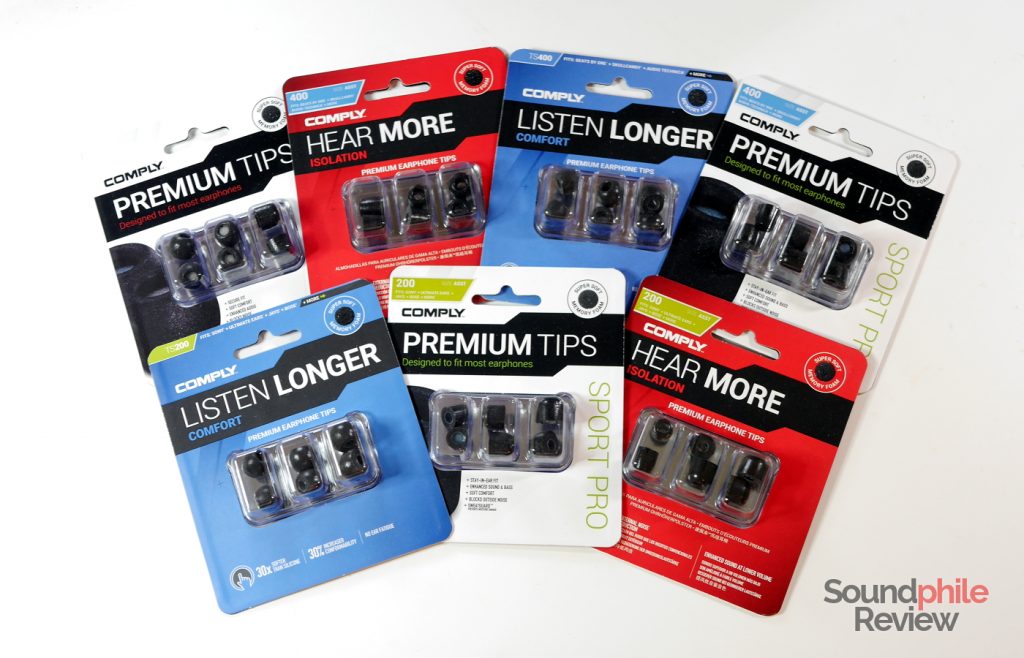
Memory foam does in fact adapt better to the ear canal and that is the cause of its substantial isolation capabilities, which are often better than those of equivalent silicone products. It also means that the foam will take the shape of your ear canal, thus providing enhanced comfort.
Foam eartips are to be changed after a few weeks of usage: foam crumbles and falls into pieces after continuous usage, and it also loses its ability to keep its shape and its elasticity. To make them last longer, it is advisable to clean them with a water-soaked cotton bud to remove all the dirt that piles up with normal use (fat, dead skin, earwax, etc). With due care, they can last for a few months, even though they will eventually and inevitably fall apart.
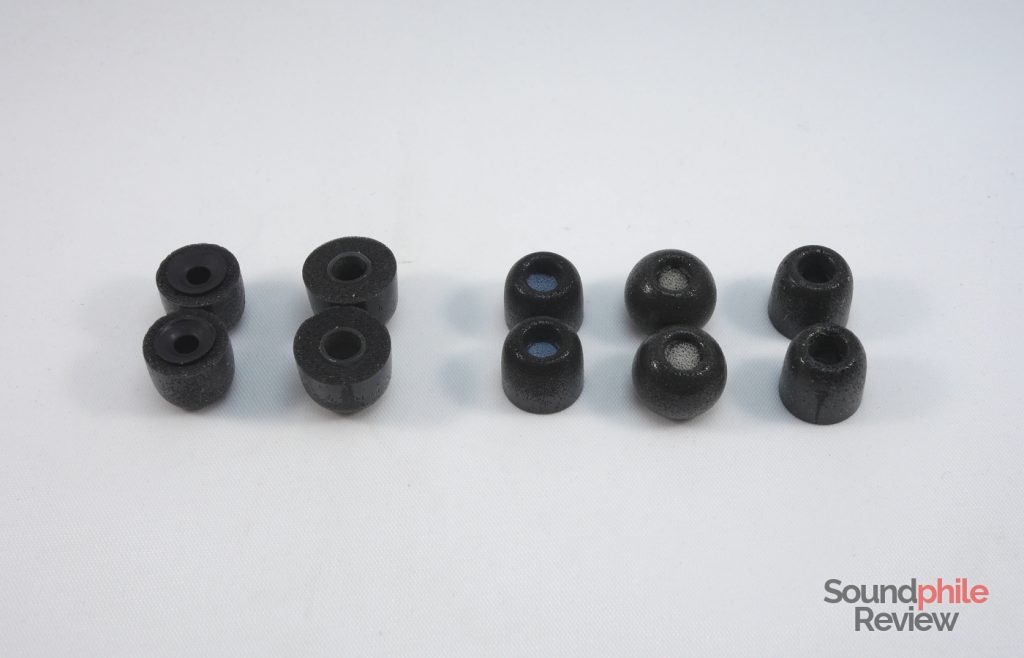
These are the different variations Comply offers, each of which can be further broke down by the inner core size (200, 400 or 500):
- Comply Comfort: their round shape makes these tips especially comfortable, as they tend not to press against the ear canal for their entire length. I found them to be better than the Isolation tips for very long runs (4+ hours), but comparable for shorter listening sessions. Isolation is almost comparable, though ever-so-slightly inferior.
- Comply Isolation: Isolation tips have a distinct conical shape which makes them press against the ear canal for their entire length, thus keeping sound from leaking in. These are the best-isolating tips I have tried so far, and the ones I choose whenever I take public transport. Comfort is great and they are ideal for daily use.
- Comply Sport: these tips are made with sport earphones in mind. They provide good isolation, long-lasting comfort and a fit which should make the earphones stay in the ear without popping out.
- Comply Audio Premium and Sport Premium: these are a variation on the Comfort and Sport models. The main difference is in the core: while the other tips have a hard plastic core, the Pro tips have a foam core which allows them to fit to most in-ear headphones irrespective of their nozzle diameter.
With the exception of the Premium line, all the Comply foams also come in a “Pro” variant which has a thin layer of foam that prevents wax and other dirt from entering into contact with the earphones. They also come in different sizes, based on the inner core diameter: 200, 400 and 500.
Disclaimer: please note the Comply foams featured in this review have been kindly provided by Comply.

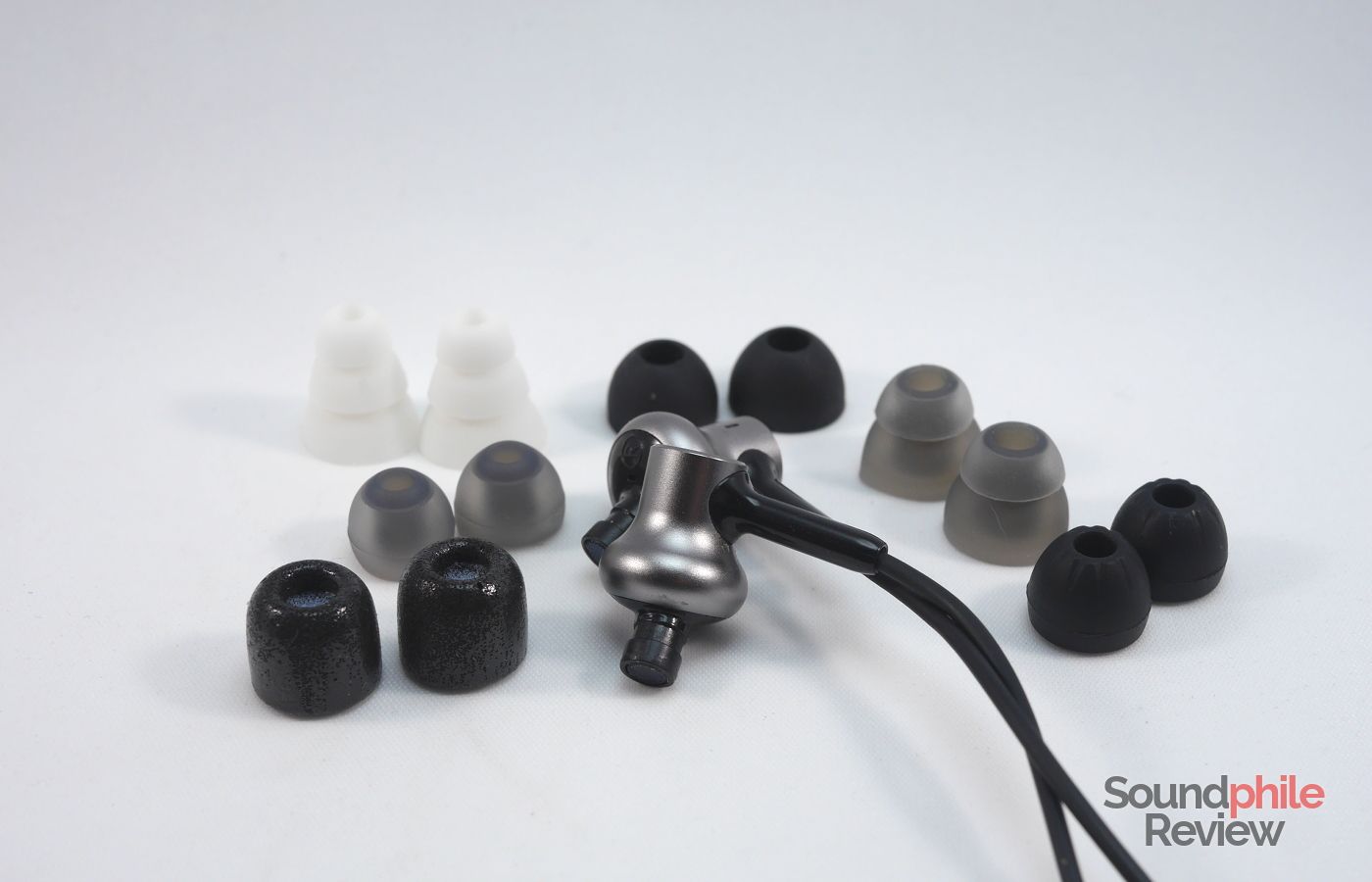
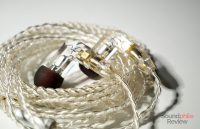
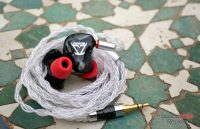
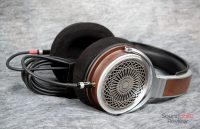


What size fits the KZ Zs6, for some reason I can not find any exact specs and am unsure of which to purchase. Thanks for your help.
Hi!
If we’re talking about Comply foams, the best size for the KZ ZS6 is the 500.
will tx400 comply do the job? since i cant find t500 in my local store
“400” and “500” indicate the diameter of the inner bore: the ZS6 have a 5 mm nozzle, so a TX400 is too small to fit (tried it myself!).
I love this article and the way you explained about eartips. With the huge verity of brans it is essential to make sure the type they purchase especially replacement ones fit their pieces.
Very well written and very helpful!
Thank you for the review!
Pretends to be reviewing different types, only mentions one brand. Paid for ad nonsense.
Man, I wish I had paid-for ads. My bank account would enjoy them.
Anyway, yesterday I received new foam eartips I will review soon (no, really: https://www.soundphilereview.com/wp-content/uploads/2018/07/Screenshot_20180703_100302.jpg).
Any non-foam alternative eartips for the kz zs6
The stock tips hurt my ears and o cant find the exact dizer for them
Hey Vinicius,
Have you looked at Symbio eartips? They’re silicone tips with foam inside. I haven’t tried them (I’ll get a pair sometime), but I read they do wonders.
Hello. Which ear tips would be best for jlab epic air sport. I will mostly be using them for working out. I was looking at faom but which do you think? Thanks a lot! john
The Comply Sport Pro should work just fine!
I have just bought the JBL C100 TWS, and the ear tips start paining after 15-20 minutes 🙁
Which ones do you recommend for them?
I really like the stock KZ silicones. I got some foam tips based on customer reviews. Comfort wise they were both comparable, but I found the foam tips sort of acted like a high pass filter. I’m not sure if it was the fit, or if maybe the foam absorbed some of the low end, but the bass sounded much more powerful using the silicones. That’s been my experience. Maybe they were bad foam tips.
That sounds about right. For kz iems I find that foam tips loose bass and overall volume
Tennmak whirlwind + cca c12 / kz zsx = auditory wet dreams
Thank you for the very helpful review! I landed here after reading your review of the xS2 earbuds so both really helpful. I have a set of Skullcandy Sesh earbuds and can’t seem to find the size of the foam tips I should buy. I wear the medium gel tips that came with them. Any help would be appreciated and thanks again!
Hey Craig,
I have no idea about the Sesh – you should take a ruler and measure the nozzle yourself. Take 1mm away from the diameter of the nozzle and you will get the size of the eartips you need!
What are those eartips with the black core and clear single flange?
They’re RHA tips.
Which silicone earths would be best for KZ zsn pro? please also recommend foam ear tips.
For the silicone ones, either single or double flange will do.
I find that KZ’s silicone tips are quite good in general, so you could stick with those; alternatively, I can suggest you to try the SpinFit. As for foam, the best are Comply’s, followed really close by Dekoni’s Bulletz. You could also try Tin HiFi’s tips, I find them to be reliable and comfortable.
is there any eartips that fit moondrop x crinacle blessing 2 dusk and has descent noise canceling
Hi,
Could you please recommend a good aftermarket tip for Symphonized NRG X. I love the sound of these In-Ears, but the stock tips are horrendous. I am constantly having to reposition them to regain the seal.
Thanks.
Hello Louis! Unfortunately I can’t find information online on what size the nozzle of the Symphonized NRG X is, so I can’t give you a specific recommendation. You could measure it and then compare it to the sizes I specified in my SpinFit eartips review, as I find those are among the best in general and there should be a compatible type among those mentioned in the review!
Thank you, Sir!